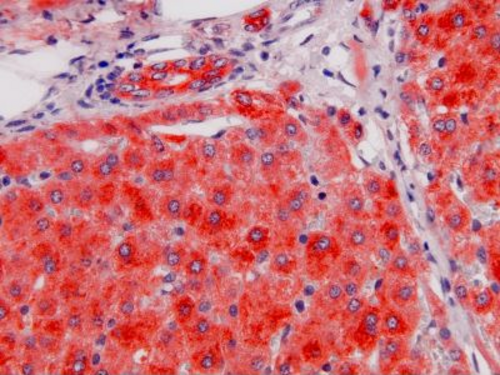HGF Mouse Monoclonal Antibody [Clone ID: PG1]
CAT#: TA363865
HGF (hepatocyte growth factor, scatter factor, SF) mouse anti porcine, clone PG1
Other products for "HGF"
Specifications
| Product Data | |
| Clone Name | PG1 |
| Applications | IHC |
| Recommended Dilution | Tested for immunohistochemistry (IHC), other applications not yet tested. Approximate working dilutions: IHC, frozen sections: 2µg/ml (1:100) IHC, paraffin sections: 4µg/ml (1:50) microwave pretreatment for antigen retrieval is recommended. Optimal dilutions should be determined by the end user. |
| Reactivities | Porcine |
| Host | Mouse |
| Isotype | IgM |
| Clonality | Monoclonal |
| Immunogen | Purified lung extract. |
| Specificity | Pig: Hepatocytes, Epithelial Cells
Other species: not tested Epitope: The antigen has tentatively been identified as Hepatocyte growth factor HGF due to the immunohistochemical staining pattern and the origin of the immunogen. The epitope has not been characterized. Further characterization is under way. Distribution: Tissue sections: The antibody reacts with hepatocytes and bile duct epithelial cells in the liver, bronchial epithelial cells and pneumocytes type ll in the lung, epithelial cells in the small intestine and the uterus, and with epithelial cell and glandular cells in the skin. |
| Formulation | Purified cell culture supernatant, supplied as liquid solution. This stock solution contains 0.2mg/ml IgM, phosphate buffered saline pH 7.2 (PBS), inert protein as stabilizer and 0.09% sodium azide as a preservative. |
| Concentration | N/A |
| Conjugation | Unconjugated |
| Storage | Original vial: 1 year at 4° - 8°C. Avoid repeated thawing and freezing. |
| Database Link | |
| Background | Monoclonal antibody PG1 mainly recognizes hepatocytes in the liver and epithelial cells in various organs. The immunohistochemical pictures suggest a close relatedness or identity of the antigen with Hepatocyte growth factor (HGF), also known as Scatter factor (SF). Hepatocyte growth factor (HGF) is a pleiotropic factor which induces cellular motility, survival, proliferation, and morphogenesis, depending upon the cell type. In the adult, HGF has been demonstrated to affect tissue repair, including in the lung. HGF is produced by cells of mesenchymal origin (mainly fibroblasts and macrophages), while the HGF receptor, Met, is expressed by epithelial and endothelial cells. HGF is a heterodimeric protein comprised of a 55–60 kDa alpha chain and a 32–34 kDa beta chain linked by a single disulfide bond. |
| Reference Data | |
Documents
| Product Manuals |
| FAQs |
| SDS |
{0} Product Review(s)
0 Product Review(s)
Submit review
Be the first one to submit a review
Product Citations
*Delivery time may vary from web posted schedule. Occasional delays may occur due to unforeseen
complexities in the preparation of your product. International customers may expect an additional 1-2 weeks
in shipping.






























































































































































































































































 Germany
Germany
 Japan
Japan
 United Kingdom
United Kingdom
 China
China




